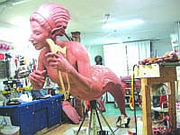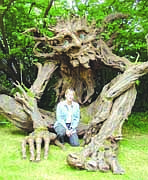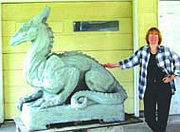Superior grad works on upcoming Hobbit movie
When Kim Graham took an aptitude test back when she was attending high school in Superior, she said that it told her she fit the criteria to be an artist.
She had dabbled with art every so often, freezing clay in the freezer until it was solid and then bringing it out to sculpt. When it softened up again, she put it back in the freezer until it was once again solid. Graham said she didn’t realize at the time that typically there is a framework inside of a piece that is being sculpted or molded.
After the test in high school, Graham said that she really didn’t do much with art and sort of wasted the talent.
“Artists starve. That’s what you do. So out of high school, I decided to get an ordinary job and art would be a hobby. I didn’t think I ought to be an artist because artists don’t make a living for the most part,” Graham said.
After graduating, Graham got a job as a house keeper and ended up cleaning homes for the wealthy around Seattle. She said she made a lot of money and continued doing that for 12 years. When she was unable to clean houses anymore, she came to a crossroad.
“I can’t do housekeeping anymore so what am I good at? The answer was nothing. I had gotten really, really good at cleaning houses and running my small business. So what can I do? Art. At this point, I’m 35 years old and let’s see if we can make a go of it. And I did,” Graham said.
Graham had only spent a little time doing art on the side and so once she decided what she wanted to, she found teachers that she wanted to learn from and hired them to teach her. She knew that she was good at art, it was a natural talent for her, but making money at it was going to be something else entirely.
It took her about seven years to finish up her schooling, which ended up being just as expensive if not more than enrolling in a school. Today, though, it seems worth it.
Graham is currently working in New Zealand, with Weta Workshop, a multi-award winning conceptual design and physical manufacturing facility that services the world’s entertainment and creative industries, on the new film The Hobbit.
But it took her awhile to get there.
She started out by creating a single piece, which she calls The Troll, based on the Ents from Lord of the Rings. Graham sculpted it out of paper mache and the entire piece weighs about 300 pounds.
“I sculpted it with a bunch of volunteers in about two weeks basically because I wanted to,” Graham said. “I’m not intimated by building large things. So I made my portfolio, printed it out and sent it to the guys over at Weta, who told me ‘sorry, no jobs.’ I thought I had missed my chance.”
Graham said that she knew that she had failed, but Richard Taylor, the co-founder and co-director of Weta, ended up giving her a call later and offered her a job.
“I stopped breathing,” Graham said. “I was darn excited. There are 5,000 applicants for 15 positions.”
Graham said that one of the things that ended up setting her portfolio apart was the fact that she could work in a vast range of things from leather, fiberglass, sculpting, welding and more. There are about 13 departments and Graham said she is able to work in seven of them.
With details of the movie being tightly kept, Graham wasn’t able to talk much about specifics that she’s been working on. She said that the best part is working with other sculptors and fabricators who are also on the project.
“The stuff that is being created is cutting edge,” Graham said. “I’m seeing the entire process on things from when they are designed to when they are built.”
Graham said that she certainly never imagined that she would be doing what she does on a day-to-day basis.
“I can remember looking at movie monster posters, but I never thought that one day I’d be here. (The film industry) is a cut throat industry and I grew up in Superior, and stayed there 19 years. Vicious people don’t grow up there. Typically, nice people don’t survive in the environment, but I’ve found a place where being a nice person counts.”
Graham said that she believes growing up in Superior also gave her a real advantage in getting work at Weta. She said that her dad had a shop in the garage that she played and worked in for most of her life.
“Moving to bigger cities made me realize how rare this is and the vast majority of people didn’t either build or fix anything themselves,” Graham said. “Working in film is all about those self taught, do-it-yourselfers, who tinker in their garages or shops. Nearly everyone working at Weta did the work at home first as part of a hobby, from the jewelry makers, leather workers, miniature artists to the sword makers.”
Working on The Hobbit and other projects she has done typically revolve around fantasy art, which Graham said she absolutely adores.
“You can always do something new with it,” Graham said. “You’ve seen cowboy art and a lot of it is regimented. It looks this way and only this way. Fantasy art is a free for all. You can always invent a new dragon, new wizard.”
And The Troll isn’t the only huge piece of art that Graham has done. In fact, she prefers building things that are huge.
“It is based on the fact, when you make a piece the size of a Buick, it gets noticed. Even if it is a dreadful sculpture, people will pay attention,” Graham said. “You will be taken more seriously as an artist. Part of that is the sheer difficultly of making big things, it shows that the artist at least has some technical skill even if they are making large replicas of thumbtacks.”
Graham said that it is her intention, though, to make her large works of art be beautiful too. She also prefers ceramic clay because you once you’ve sculpted it, you can fire it into a permanent piece, which allows you to “keep all the original vitality without sacrificing much to the process of making copies.”
Ultimately, Graham says that she was “destined” to be an artist even if she may have shrugged it off at first.







